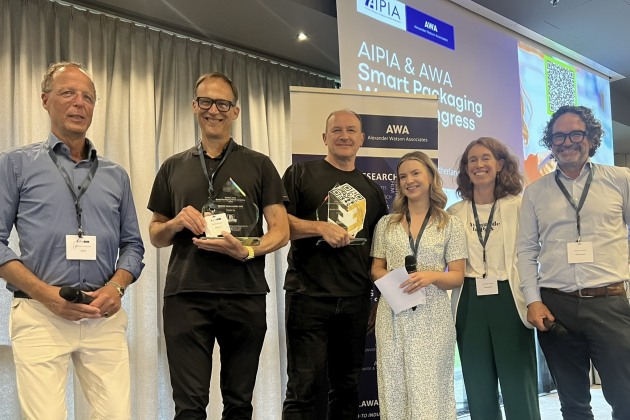The AIPIA & AWA World Congress 2025 delivered a packed two-day programme with brand owners, solution providers, and innovators showcasing how smart packaging is moving from concept to commercial reality.

Apocryphal wisdom says that if you leave a conference with just one valuable idea, contact, or innovation, it’s been time well spent. These days, with companies far more selective about how they invest employees’ time and resources, events must deliver high-impact takeaways alongside networking and data-gathering opportunities. Judging by delegate feedback, the AIPIA & AWA World Congress, held in Amsterdam in late June, did just that.
The two-day event opened and closed with strong endorsements from major brand owners. McCormick, the global leader in flavour, and Kellanova, home to iconic brands including Pringles, shared how smart packaging is becoming integral to their strategies for innovation, sustainability, and consumer engagement. McCormick’s Jessica Krauze, EMEA growth platforms marketing manager, outlined how connected, intelligent, and sustainable packaging is being integrated to enhance authenticity, improve supply chain transparency, and elevate consumer experiences. Kellanova’s team unpacked how interactive technologies are shaping brand–consumer relationships, supported by case studies showing the opportunities and challenges for both brands and solution providers.
Connectivity and Standards
Connectivity emerged as the defining theme, starting with GS1’s chief product officer, Robert Beideman. In his keynote The Crossroads of Consumer Engagement, Regulatory Compliance and AI Disruption, Beideman made a compelling case for GS1 Digital Link as a means to connect products with authoritative data, driving sustainability, efficiency, consumer engagement, and simplified compliance. He emphasised the role of global standards in enabling these outcomes, while highlighting the potential for AI to accelerate innovation.
From there, the programme explored connected product strategies in depth. Markem-Imaje’s Rémy Fontanet examined the shift from 1D to 2D barcodes and the operational challenges of transition. In pharmaceutical logistics, Identiv’s Klaus Simonmeyer and Tag-N-Trac’s Venu Gutlapalli outlined how IoT-driven, real-time monitoring can transform cold chain systems, prevent theft, and support sustainability goals.
Digital Product Passports (DPPs) – an area where smart packaging is proving essential – were the focus of a lively panel featuring Simonmeyer, Gutlapalli, AmbAI’s Steve Statler, Narravero’s Thomas L. Roedding, NFC Forum’s Mike McCamon, and STMicroelectronics’ Jean-Rémi Ruiz. The discussion showed how technologies such as NFC, QR, and RFID, supported by blockchain, form the bridge between brands, consumers, and supply chain partners.
Other highlights included Beontag and Vytal’s collaborative approach to scaling reusable food packaging with RFID and digital platforms; CL Circular’s Erich Hugo on harnessing AI and IoT to deliver leaner, more sustainable supply chains; and Dracula Technologies’ breakthrough smart label modules.
Rapid-Fire Innovation
As part of the Congress, McCormick hosted the 2025 Brand Challenge, giving 12 companies just three minutes each to pitch connected packaging solutions. The energy-filled session, moderated by AIPIA managing director Eef de Ferrante, resulted in three companies being selected for further discussions with McCormick:
Scantrust (Nathan Anderson) – QR code solutions enabling brands to manage millions of codes across thousands of SKUs, automate campaigns, and integrate anti-counterfeiting measures while meeting EU digital labelling requirements.
AmbAI (Steve Statler) – AI-driven architecture enabling consumers to keep personal product data local, while allowing brands direct access to provide tailored recipes, shopping lists, and services.
Experience is Everything (Paul Simonet) – always-on connected packaging solutions to strengthen brand–consumer engagement and deliver measurable sales impact. Simonet also co-founded the Interactive Brand Packaging Network, launched at the Congress.
“This is always a great way to round off the Congress,” said de Ferrante. “The strong support from McCormick, other brands, and our members shows we’re going in the right direction.”
Packaging as a Media Channel
The debut of the Interactive Brand Packaging Network (IBPN) was a major milestone for the Congress. Co-founded by Paul Simonet and Appetite Creative’s managing director Jenny Stanley, the IBPN aims to establish frameworks for measuring and maximising connected packaging ROI, repositioning packaging from a purely functional container to a strategic media asset.
The IBPN track opened with Martin Radford from AudienceProject, who outlined how connected packaging captures consumer attention and delivers measurable engagement. Simonet followed with a data-driven analysis showing connected packaging’s unmatched efficiency as a media channel: zero wastage, direct consumer contact, and quantifiable ROI.
A case study from Kellanova’s Roisin Devine and Tim Ridding demonstrated the real-world impact of connected packaging on the Pringles brand, with strategies that can be replicated across FMCG portfolios.
A panel discussion moderated by Stanley explored where connected packaging is headed, with insights from Kellanova, Checkpoint Systems, and GS1. Themes included Tesco’s trials, the GS1 Sunrise 2D code transition, and regulatory pressures such as the EU’s Digital Product Passport legislation.
Creativity, Differentiation, and CEO-Level Commitment
Day two’s keynote by Patrick Collister – former Ogilvy & Mather executive creative director and ex-Google creative director – was described as “absolutely gripping”. Collister challenged brands to rethink communication strategies, warning that 81% of brands could disappear without consumers noticing. He argued that connected packaging offers a medium that consumers like, allowing brands to build meaningful relationships through integrated storytelling.
His examples, including LVMH’s Olympic medal box and the $3 trillion US personalisation spend, illustrated the untapped creative potential of packaging. The message was clear: without CEO-level commitment to packaging innovation, brands risk missing opportunities to differentiate and connect.
A Strong Industry Response
The IBPN launch and broader Congress programme drew praise from brand attendees including Barilla, Coca-Cola, Kellanova, and Danone, who valued both the practical insights and the opportunity to meet peers and experts in a fast-evolving field.
“The response has been exceptional,” said de Ferrante. “What we’ve seen is industry recognition that connected packaging isn’t just the future – it’s the present reality for brands serious about meaningful consumer engagement.”
Industry veteran Andrew Manly is communications director at AIPIA, an honorary member of the International Packaging Press Organisation, and a regular contributor to PKN.
This article was first published in the September-October 2025 print issue of PKN Packaging News, p46






